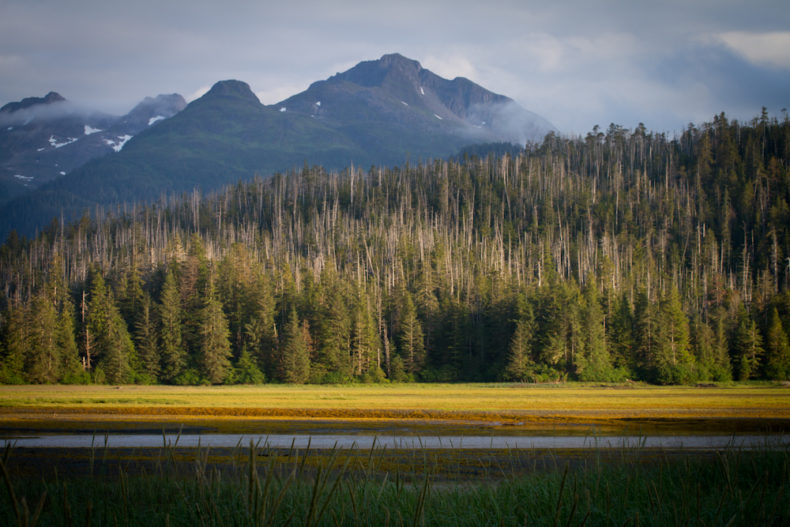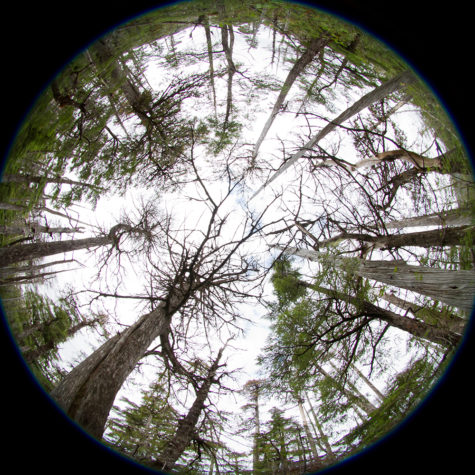 The Alexander Archipelago, a 300-mile-long sweep of islands off the southeastern coast of Alaska, is known for its isolation, its heavy rain, and its thick, ancient forests of hemlock, pine, spruce and yellow-cedar. Yellow-cedar, which John Muir called a “truly noble tree,” has long been prized for its fine-grained, butter-colored wood. But over the past century, as average temperatures have risen, shrinking spring snow cover has exposed more and more of the species’ shallow roots to freezing temperatures, and yellow-cedars have been dying off. Because the tree was and is used for so many human purposes—canoe paddles, ceremonial carvings, even bridges—the disruption is both ecological and cultural.
The Alexander Archipelago, a 300-mile-long sweep of islands off the southeastern coast of Alaska, is known for its isolation, its heavy rain, and its thick, ancient forests of hemlock, pine, spruce and yellow-cedar. Yellow-cedar, which John Muir called a “truly noble tree,” has long been prized for its fine-grained, butter-colored wood. But over the past century, as average temperatures have risen, shrinking spring snow cover has exposed more and more of the species’ shallow roots to freezing temperatures, and yellow-cedars have been dying off. Because the tree was and is used for so many human purposes—canoe paddles, ceremonial carvings, even bridges—the disruption is both ecological and cultural.
Ecologist Lauren Oakes wanted to know how the rest of the forest was responding to this long upheaval, so in the summers of 2011 and 2012, she and her field crew sampled forest stands in the archipelago, comparing tree size and species composition at different stages of yellow-cedar decline. In the south, where the decline is most advanced, she found that while some very old yellow-cedars are hanging on, there are few young trees—and those are usually outcompeted by other species such as western hemlock and Sitka spruce.
Oakes had glimpsed the future of the forest, and she wanted to communicate what she’d seen—especially to the people whose lives are still shaped by yellow-cedar. So after she summarized her results in the language of science—bar graphs, charts, and scatter plots—she decided to use the language of music, too.
Oakes shared her data with Nik Sawe, a fellow Stanford Ph.D. student and amateur musician who is experimenting with “data sonification,” or the translation of information into sound. Simple sonifications are often used for emergencies (four-alarm fires) and in assistive  technologies (audible crosswalk signs), but in recent years, scientists and musicians have begun to sonify much more complicated datasets. Musician Brian Foo has sonified data on income inequality in New York City, land loss in Louisiana, and air quality in Beijing. This year, scientists at LIGO translated the minute spacetime vibrations created by gravitational waves into audible burps and chirps.
technologies (audible crosswalk signs), but in recent years, scientists and musicians have begun to sonify much more complicated datasets. Musician Brian Foo has sonified data on income inequality in New York City, land loss in Louisiana, and air quality in Beijing. This year, scientists at LIGO translated the minute spacetime vibrations created by gravitational waves into audible burps and chirps.
Since our ears are especially sensitive to patterns, sonifications can help scientists more fully communicate their results to the public—and even recognize hidden patterns in their own data. “Researchers are always talking about multidimensional space, but that means nothing to the public, and it’s even hard to understand as a scientist,” says Oakes. “What’s so cool about sound is that you can hear all the variables at the same time.”
To represent the changing forests of the Alexander Archipelago in music, Sawe used a different instrument or group of instruments for each of the five conifer species Oakes measured—piano for yellow-cedar, flute for western hemlock, cello and bass for Sitka spruce, violin and viola for mountain hemlock, and clarinet for shore pine. In the clip above, each note represents a tree, and its pitch and how hard it’s hit corresponds with the tree’s height and diameter. (Lower, shorter notes stand for younger trees, while higher, longer notes stand for older ones.) Dead trees are represented by dropped notes—gaps of silence that widen as the sonification moves from the cooler study plots in the north to the warmer plots in the south. The spreading silence in this “species solo” by yellow-cedar is, in effect, the sound of climate change:
While these sonifications are faithful to Oakes’ data, Sawe did have some artistic license. He chose, for instance, to set them in a minor key, and to represent the ascendant western hemlock with a relatively quiet flute. Put the pieces in a major key, switch the flute for a trumpet, and an elegy might become a story of adaptation and recovery.
Oakes, who also conducted extensive interviews with people affected by the decline of yellow-cedar, has noticed a similar variation in human reactions. “You can focus on the silences or the sadness, or you can focus on what’s coming in,” she observes. The data doesn’t change, but our responses to its patterns can be set in any key—even all of them at once.
Photos of forests affected by yellow-cedar decline in southeastern Alaska courtesy of Lauren Oakes. Sound clips courtesy of Nik Sawe.
Wonderful symbiosis of science and art! Since the original data was in a visual, although static, form, I’m wondering if this sonification of it could be accompanied in some way by a dynamic visual display of the data that would illustrate the measured changes in the forest’s health in harmony with the music?
Thank you for this work. As someone studying to be a therapeutic musician, and an acupuncturist who enjoys working with Acutonics tuning forks on the body, I appreciate this no end. It is beautiful and also sad.